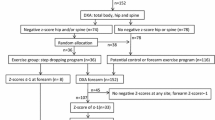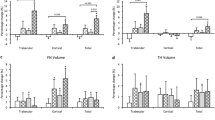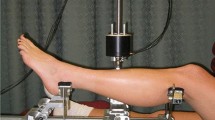Abstract
Introduction: The purpose of this randomized controlled study was to assess the effects of high-impact exercise on the bone mineral density (BMD) of premenopausal women at the population level. Materials and methods: The study population consisted of a random population-based sample of 120 women from a cohort of 5,161 women, aged 35 to 40 years. They were randomly assigned to either an exercise or control group. The exercise regimen consisted of supervised, progressive high-impact exercises three times per week and an additional home program for 12 months. BMD was measured on the lumbar spine (L1–L4), proximal femur, and distal forearm, by dual-energy X-ray absorptiometry at baseline and after 12 months. Calcaneal bone was measured using quantitative ultrasound. Results: Thirty-nine women (65%) in the exercise group and 41 women (68%) in the control group completed the study. The exercise group demonstrated significant change compared with the control group in femoral neck BMD (1.1% vs −0.4%; p=0.003), intertrochanteric BMD (0.8% vs −0.2%; p=0.029), and total femoral BMD (0.1% vs −0.3%; p=0.006). No exercise-induced effects were found in the total lumbar BMD or in the lumbar vertebrae L2–L4. Instead, L1 BMD (2.2% vs −0.4%; p=0.002) increased significantly more in the exercise group than in the control group. Calcaneal broadband ultrasound attenuation showed also a significant change in the exercise group compared with the control group (7.3% vs −0.6%; p=0.015). The changes were also significant within the exercise group, but not within the control group. There were no significant differences between or within the groups in the distal forearm. Conclusions: This study indicates that high-impact exercise is effective in improving bone mineral density in the lumbar spine and upper femur in premenopausal women, and the results of the study may be generalized at the population level. This type of training may be an efficient, safe, and inexpensive way to prevent osteoporosis later in life.


Similar content being viewed by others
References
Kannus P, Parkkari J, Niemi S (1995) Age-adjusted incidence of hip fractures. Lancet 346:50–51
Melton LJ III, Chrischilles EA, Cooper C, Lane AW, Riggs BL (1992) Perspective. how many women have osteoporosis? J Bone Miner Res 7:1005–1010
Melton LJ III, Gabriel SE, Crowson CS, Tosteson AN, Johnell O, Kanis JA (2003) Cost-equivalence of different osteoporotic fractures. Osteoporos Int 14:383–388
Campbell AJ, Robertson MC, Gardner MM, Norton RN, Tilyard MW, Buchner DM (1997) Randomised controlled trial of a general practice programme of home based exercise to prevent falls in elderly women. BMJ 315:1065–1069
Kelley GA (1998) Exercise and regional bone mineral density in postmenopausal women: a meta-analytic review of randomized trials. Am J Phys Med Rehabil 77:76–87
Wolff I, van Croonenborg JJ, Kemper HC, Kostense PJ, Twisk JW (1999) The effect of exercise training programs on bone mass: a meta-analysis of published controlled trials in pre- and postmenopausal women. Osteoporos Int 9:1–12
Ulrich CM, Georgiou CC, Gillis DE, Snow CM (1999) Lifetime physical activity is associated with bone mineral density in premenopausal women. J Womens Health 8:365–375
Bakker I, Twisk JW, Van Mechelen W, Roos JC, Kemper HC (2003) Ten-year longitudinal relationship between physical activity and lumbar bone mass in young adults. J Bone Miner Res 18:325–332
Wallace BA, Cumming RG (2000) Systematic review of randomized trials of the effect of exercise on bone mass in pre- and postmenopausal women. Calcif Tissue Int 67:10–18
NIH Consensus Development Panel on Osteoporosis Prevention Diagnosis and Therapy (2001) Osteoporosis prevention, diagnosis, and therapy. JAMA 285:785–795
Kontulainen S, Heinonen A, Kannus P, Pasanen M, Sievänen H, Vuori I (2004) Former exercisers of an 18-month intervention display residual aBMD benefits compared with control women 3.5 years post-intervention: a follow-up of a randomized controlled high-impact trial. Osteoporos Int 15:248–251
Snow-Harter C, Bouxsein ML, Lewis BT, Carter DR, Marcus R (1992) Effects of resistance and endurance exercise on bone mineral status of young women: a randomized exercise intervention trial. J Bone Miner Res 7:761–769
Bassey EJ, Ramsdale SJ (1994) Increase in femoral bone density in young women following high-impact exercise. Osteoporos Int 4:72–75
Lohman T, Going S, Pamenter R, Hall M, Boyden T, Houtkooper L, Ritenbaugh C, Bare L, Hill A, Aickin M (1995) Effects of resistance training on regional and total bone mineral density in premenopausal women: a randomized prospective study. J Bone Miner Res 10:1015–1024
Friedlander AL, Genant HK, Sadowsky S, Byl NN, Glüer CC (1995) A two-year program of aerobics and weight training enhances bone mineral density of young women. J Bone Miner Res 10:574–585
Heinonen A, Kannus P, Sievänen H, Oja P, Pasanen M, Rinne M, Uusi-Rasi K, Vuori I (1996) Randomised controlled trial of effect of high-impact exercise on selected risk factors for osteoporotic fractures. Lancet 348:1343–1347
Snow CM (1996) Exercise and bone mass in young and premenopausal women. Bone 18:51S-55S
Jaglal SB, Kreiger N, Darlington GA (1995) Lifetime occupational physical activity and risk of hip fracture in women. Ann Epidemiol 5:321–324
Greendale GA, Barrett-Connor E, Edelstein S, Ingles S, Haile R (1995) Lifetime leisure exercise and osteoporosis. The Rancho Bernardo study. Am J Epidemiol 141:951–959
Tuppurainen M, Kröger H, Saarikoski S, Honkanen R, Alhava E (1995) The effect of gynecological risk factors on lumbar and femoral bone mineral density in peri- and postmenopausal women. Maturitas 21:137–145
Bassey EJ, Rothwell MC, Littlewood JJ, Pye DW (1998) Pre- and postmenopausal women have different bone mineral density responses to the same high-impact exercise. J Bone Miner Res 13:1805–1813
Smith EL, Gilligan C, McAdam M, Ensign CP, Smith PE (1989) Deterring bone loss by exercise intervention in premenopausal and postmenopausal women. Calcif Tissue Int 44:312–321
Sinaki M, Wahner H, Bergstralh EJ, Hodgson SF, Offord KP, Squires RW, Swee RG, Kao P (1996) Three-year controlled, randomized trial of the effect of dose-specified loading and strengthening exercises on bone mineral density of spine and femur in nonathletic, physically active women. Bone 19:233–244
Gleeson PB, Protas EJ, LeBlanc AD, Schneider VS, Evans HJ (1990) Effects of weight lifting on bone mineral density in premenopausal women. J Bone Miner Res 5:153–158
Rockwell JC, Sorensen AM, Baker S, Leahey D, Stock JL, Michaels J, Baran DT (1990) Weight training decreases vertebral bone density in premenopausal women: a prospective study. J Clin Endocrinol Metab 71:988–993
Leichter I, Simkin A, Margulies JY, Bivas A, Steinberg R, Giladi M, Milgrom C (1989) Gain in mass density of bone following strenuous physical activity. J Orthop Res 7:86–90
Hodges PW, Richardson CA (1996) Inefficient muscular stabilization of the lumbar spine associated with low back pain: a motor control evaluation of transversus abdominis. Spine 21:2640–2650
Brinckmann P, Frobin W, Leivseth G (eds) (2002) Musculoskeletal biomechanics. Georg Thieme Verlag, New York
Takata S, Ikata T, Yonezu H (2000) Characteristics of regional bone mineral density and soft tissue composition in patients with atraumatic vertebral fractures. J Bone Miner Metab 18:287–290
Davis JW, Grove JS, Wasnich RD, Ross PD (1999) Spatial relationships between prevalent and incident spine fractures. Bone 24:261–264
Ferguson SJS (2003) Biomechanics of the aging spine. Eur Spine J 12:S97–S103
Takata S, Yasui N (2002) Effects of constitution, atraumatic vertebral fracture and aging on bone mineral density and soft tissue composition in women. J Med Invest 49:18–24
Nguyen T, Sambrook P, Eisman J (1998) Bone loss, physical activity, and weight change in elderly women: the Dubbo Osteoporosis Epidemiology Study. J Bone Miner Res 13:1458–1467
Salamone LM, Cauley JA, Black DM, Simkin-Silverman L, Lang W, Gregg E, Palermo L, Epstein RS, Kuller LH, Wing R (1999) Effect of a lifestyle intervention on bone mineral density in premenopausal women: a randomized trial. Am J Clin Nutr 70:97–103
Sirola J, Kröger H, Honkanen R, Sandini L, Tuppurainen M, Jurvelin JS, Saarikoski S (2003) Risk factors associated with peri- and postmenopausal bone loss: does HRT prevent weight loss-related bone loss? Osteoporos Int 14:27–33
Acknowledgements
The authors would like to express special thanks to Minna Tervo, physiotherapist in our study, for her dedication and hard work in supervising the training and testing of our subjects. We thank Ms Sari-Anna Vaara and Ms Arja Retsu for performing the bone scans, Pentti Nieminen, Ph.D., for statistical advice, and the whole staff of the Department of Sports Medicine in the Deaconess Institute of Oulu for their assistance. Financial support was provided by the National Technology Agency of Finland; Newtest, Oulu, Finland; the Juho Vainio Foundation; and the Finnish Foundation for Sports Research.
Author information
Authors and Affiliations
Corresponding author
Rights and permissions
About this article
Cite this article
Vainionpää, A., Korpelainen, R., Leppäluoto, J. et al. Effects of high-impact exercise on bone mineral density: a randomized controlled trial in premenopausal women. Osteoporos Int 16, 191–197 (2005). https://doi.org/10.1007/s00198-004-1659-5
Received:
Accepted:
Published:
Issue Date:
DOI: https://doi.org/10.1007/s00198-004-1659-5




